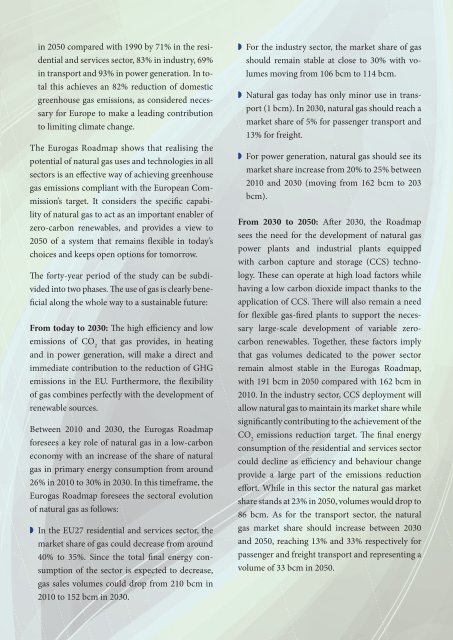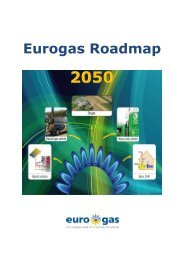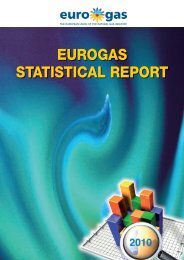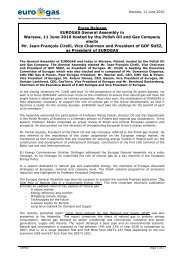Eurogas Roadmap 2050 - summary
Eurogas Roadmap 2050 - summary
Eurogas Roadmap 2050 - summary
Create successful ePaper yourself
Turn your PDF publications into a flip-book with our unique Google optimized e-Paper software.
in <strong>2050</strong> compared with 1990 by 71% in the residentialand services sector, 83% in industry, 69%in transport and 93% in power generation. In totalthis achieves an 82% reduction of domesticgreenhouse gas emissions, as considered necessaryfor Europe to make a leading contributionto limiting climate change.The <strong>Eurogas</strong> <strong>Roadmap</strong> shows that realising thepotential of natural gas uses and technologies in allsectors is an effective way of achieving greenhousegas emissions compliant with the European Commission’starget. It considers the specific capabilityof natural gas to act as an important enabler ofzero-carbon renewables, and provides a view to<strong>2050</strong> of a system that remains flexible in today’schoices and keeps open options for tomorrow.The forty-year period of the study can be subdividedinto two phases. The use of gas is clearly beneficialalong the whole way to a sustainable future:From today to 2030: The high efficiency and lowemissions of CO 2that gas provides, in heatingand in power generation, will make a direct andimmediate contribution to the reduction of GHGemissions in the EU. Furthermore, the flexibilityof gas combines perfectly with the development ofrenewable sources.Between 2010 and 2030, the <strong>Eurogas</strong> <strong>Roadmap</strong>foresees a key role of natural gas in a low-carboneconomy with an increase of the share of naturalgas in primary energy consumption from around26% in 2010 to 30% in 2030. In this timeframe, the<strong>Eurogas</strong> <strong>Roadmap</strong> foresees the sectoral evolutionof natural gas as follows:◗ In the EU27 residential and services sector, themarket share of gas could decrease from around40% to 35%. Since the total final energy consumptionof the sector is expected to decrease,gas sales volumes could drop from 210 bcm in2010 to 152 bcm in 2030.◗ For the industry sector, the market share of gasshould remain stable at close to 30% with volumesmoving from 106 bcm to 114 bcm.◗ Natural gas today has only minor use in transport(1 bcm). In 2030, natural gas should reach amarket share of 5% for passenger transport and13% for freight.◗ For power generation, natural gas should see itsmarket share increase from 20% to 25% between2010 and 2030 (moving from 162 bcm to 203bcm).From 2030 to <strong>2050</strong>: After 2030, the <strong>Roadmap</strong>sees the need for the development of natural gaspower plants and industrial plants equippedwith carbon capture and storage (CCS) technology.These can operate at high load factors whilehaving a low carbon dioxide impact thanks to theapplication of CCS. There will also remain a needfor flexible gas-fired plants to support the necessarylarge-scale development of variable zerocarbonrenewables. Together, these factors implythat gas volumes dedicated to the power sectorremain almost stable in the <strong>Eurogas</strong> <strong>Roadmap</strong>,with 191 bcm in <strong>2050</strong> compared with 162 bcm in2010. In the industry sector, CCS deployment willallow natural gas to maintain its market share whilesignificantly contributing to the achievement of theCO 2emissions reduction target. The final energyconsumption of the residential and services sectorcould decline as efficiency and behaviour changeprovide a large part of the emissions reductioneffort. While in this sector the natural gas marketshare stands at 23% in <strong>2050</strong>, volumes would drop to86 bcm. As for the transport sector, the naturalgas market share should increase between 2030and <strong>2050</strong>, reaching 13% and 33% respectively forpassenger and freight transport and representing avolume of 33 bcm in <strong>2050</strong>.








